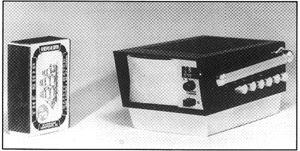|
Microvision
Sinclair Radionics, 1966
 As
early as 1963, even before he had gone into business for himself,
Clive Sinclair was fascinated by the possibility of producing
a miniature television. The difficulties were considerable.
The biggest problem was that of powering the display: liquid-crystal
displays were not invented until the 1970s, forcing Sinclair
to rely on miniaturised versions of the cathode-ray tubes
(CRTs) used on conventional televisions and monitors. Even
when shrunk, CRTs demanded a considerable amount of power.
It was also extremely difficult finding suitable miniature
CRTs in the first place. As
early as 1963, even before he had gone into business for himself,
Clive Sinclair was fascinated by the possibility of producing
a miniature television. The difficulties were considerable.
The biggest problem was that of powering the display: liquid-crystal
displays were not invented until the 1970s, forcing Sinclair
to rely on miniaturised versions of the cathode-ray tubes
(CRTs) used on conventional televisions and monitors. Even
when shrunk, CRTs demanded a considerable amount of power.
It was also extremely difficult finding suitable miniature
CRTs in the first place.
Sinclair nonetheless was able
to obtain the CRTs he needed from Hitachi. By 1966, the Sinclair
team had advanced to the point where they were able to display
a prototype miniature TV, dubbed the Microvision, at
the Radio and Television Show at Olympia.
 The
prototype Microvision was a 2" 405-line receiver which
would handle all 13 channels in bands I to III. The speaker
was a 2" piezoelectric transducer with an overall depth
of less than ¼". The set was powered by six pen
light cells, and its total power consumption was less than
450mW, including less than 100mW for the tube heater. Its
weight, including the battery, was 10.5 oz. The cathode-ray
tube was designed by Twentieth Century Electronics and focused
using magnetic deflection. The
prototype Microvision was a 2" 405-line receiver which
would handle all 13 channels in bands I to III. The speaker
was a 2" piezoelectric transducer with an overall depth
of less than ¼". The set was powered by six pen
light cells, and its total power consumption was less than
450mW, including less than 100mW for the tube heater. Its
weight, including the battery, was 10.5 oz. The cathode-ray
tube was designed by Twentieth Century Electronics and focused
using magnetic deflection.
Although Sinclair prematurely
advertised the Microvision as being an "amazing Sinclair
trumph" available from 1967 for 49 guineas (right),
the device never went into production. It was simply too difficult
to manufacture, test, service and repair, due to the way that
it had been constructed. Technology had also moved on, and
the Microvision returned to the drawing board for another
decade.

Back
to top
© Chris Owen 1994-2003
|